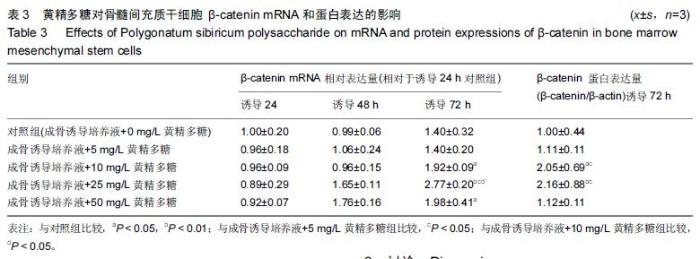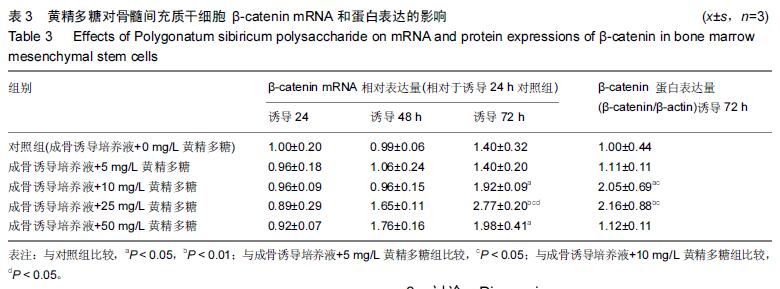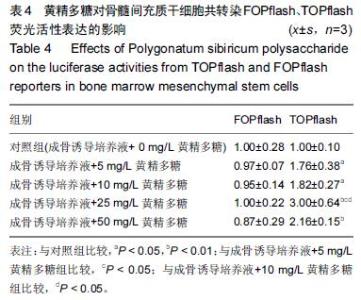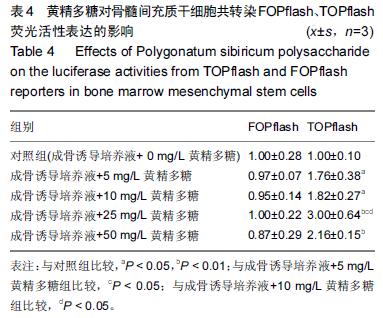| [1] Pittenger MF, Mackay AM, Beck SC, et al. Multilineage potential of adult human mesenchymal stem cells. Science.1999;284(5411):143-147. [2] Lagari VS, Levis S. Phytoestrogens in the prevention of postmenopausal bone loss. J Clin Densitom. 2013;16(4): 445-449. [3] Lagari VS, Levis S. Phytoestrogens for menopausal bone loss and climacteric symptoms.J Steroid Biochem Mol Biol.2014;139(1): 294-301. [4] 崔亦华,崔英德,易国斌.应用广泛的天然多糖及其提取方法[J].广州化工,2002, 30(3): 7-9. [5] 何才通,李文.黄精多糖药理功效研究进展[J].新中医, 2014, 46(3): 196-199. [6] 雷震,杨光义,叶方,等.黄精多糖药理作用及临床应用研究概述[J].中国药师, 2012, 15(1): 114-116. [7] 曾高峰,张志勇,鲁力,等.黄精多糖对骨质疏松性骨折大鼠骨代谢因子的影响[J].中国组织工程研究与临床康复, 2011, 15(33): 6199-6202. [8] Zeng GF, Zhang ZY, Lu L, et al. Protective effects of Polygonatum sibiricum polysaccharide on ovariectomy- induced bone loss in rats. J Ethnopharmacol.2011; 136(1): 224-229. [9] 曾高峰,张志勇,鲁力,等.多糖干预骨质疏松模型大鼠的作用及机制[J].中国组织工程研究, 2012,16(50): 9471-9478. [10] Clevers H, Nusse R. Wnt/β-catenin signaling and disease. Cell.2012;149(6):1192-1205. [11] Baron R, Kneissel M. WNT signaling in bone homeostasis and disease: from human mutations to treatments. Nat Med. 2013;19(2): 179-192. [12] Manolagas SC. Wnt signaling and osteoporosis. Maturitas.2014;78(3):233-237. [13] Wang YP, Li YP, Paulson C, et al. Wnt and the Wnt signaling pathway in bone development and disease. Front Biosci (Landmark Ed), 2014;19: 379-407. [14] 李府,沈柏均.间充质干细胞的来源、特性及临床应用前景[J].国外医学(儿科学分册), 2004, 31(2): 104-107. [15] Satija NK, Gurudutta GU, Sharma S, et al. Mesenchymal stem cells: molecular targets for tissue engineering. Stem Cells Dev.2007;16(1): 7-23. [16] 廖庆辉,黄震,蔡德鸿.抗坏血酸、β-甘油磷酸钠和地塞米松联合诱导大鼠骨髓间充质干细胞向成骨细胞的分化[J]. 中国组织工程研究与临床康复,2009, 13(1): 88-91. [17] 张建萍.不同浓度地塞米松在体外定向诱导分化兔骨髓间充质干细胞为成骨细胞的实验研究[J]. 现代中西医结合杂志, 2012, 21(24): 2642-2645+2691. [18] 曾高峰,宗少晖,邹斌,等.黄精多糖对小鼠骨髓间充质干细胞向成骨细胞分化中PINP和BMP-2表达的影响[J].天然产物研究与开发, 2014, 26(8): 1188-1192. [19] 文珠,胡国柱,俞火,等.黄精多糖干预长春新碱抑制骨髓基质细胞增殖的研究[J].中华中医药杂志, 2011, 26(7): 1630-1632. [20] Westendorf JJ, Kahler RA, Schroeder TM. Wnt signaling in osteoblasts and bone diseases. Gene. 2004;341: 19-39. [21] Rawadi G, Roman RS. Wnt signalling pathway: a new target for the treatment of osteoporosis. Expert Opin Ther Targets.2005;9(5): 1063-1077. [22] Wang PP, Zhu XF, Yang L, et al. Puerarin stimulates osteoblasts differentiation and bone formation through estrogen receptor, p38 MAPK, and Wnt/β-catenin pathways. J Asian NatProd Res.2012;14(9): 897-905. [23] Pan LL,Shi XG,Liu S,et al.Fluoride promotes osteoblastic differentiation through canonical Wnt/β-catenin signaling pathway. Toxicol Lett.2014;225(1): 34-42. [24] Zhou HB,Shang LS,Li X, et al.Resveratrol augments the canonical Wnt signaling pathway in promoting osteoblastic differentiation of multipotent mesenchymal cells. Experimental Cell Research.2009;315(17): 2953-2962. |







